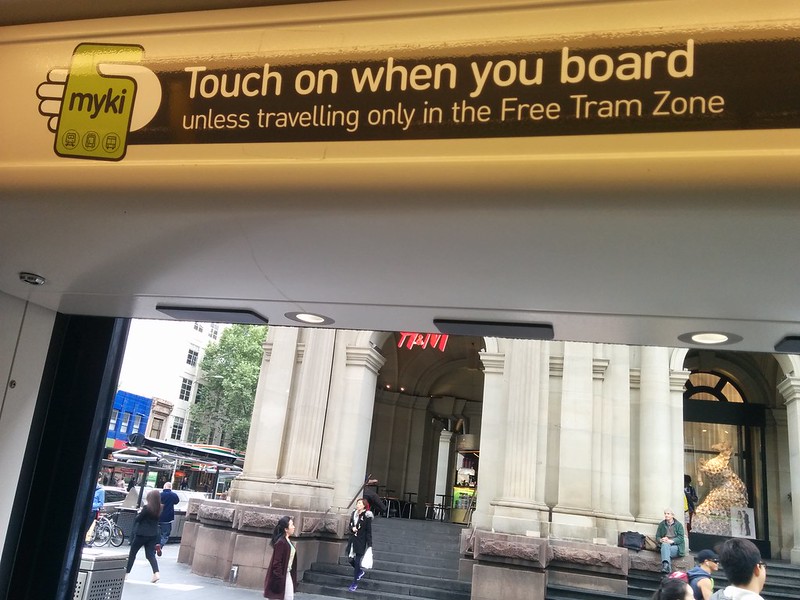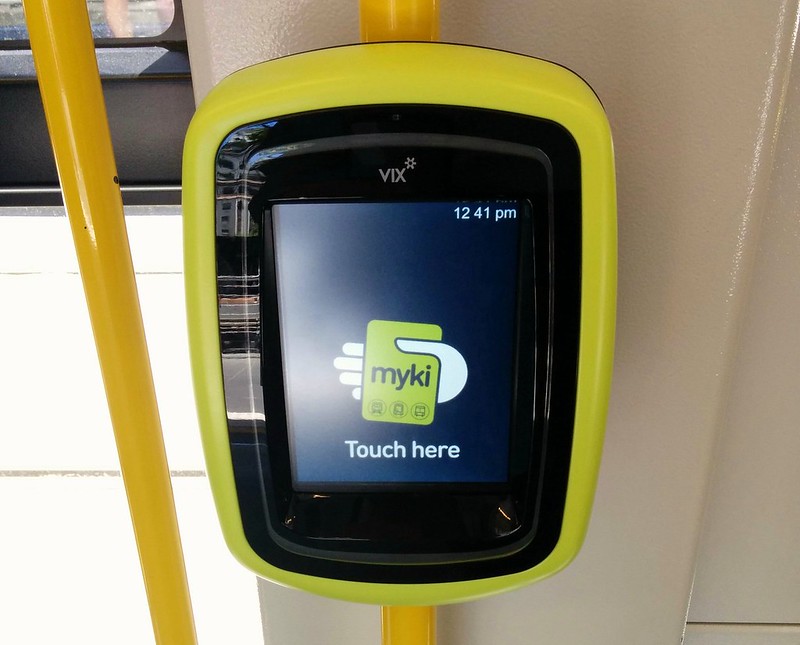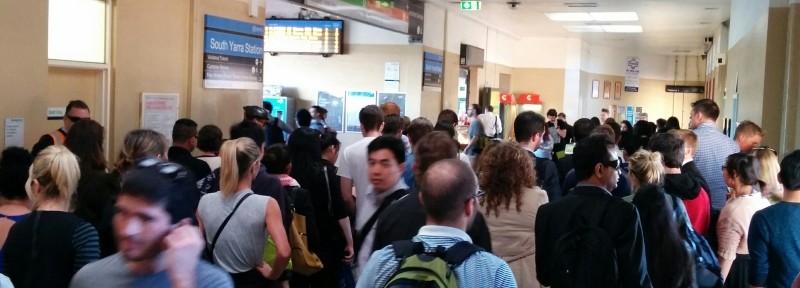One of the things they got right about Myki was designing it to be “open architecture”. This of course came at a cost compared with simply buying an off-the-shelf system, but it does mean that it’s modular — different bits can be improved and upgraded over time without replacing the whole system at enormous cost.
Thus, all CBD station and some suburban station gates have had new readers installed which are faster — up to the speed seen on systems elsewhere — and cope better with the number of people that use them.
Now they’ve started to appear on trams, and as you can see from this Vine, they are lightning fast:
This is a vast improvement. Unlike their railway station brethren, they show your card balance (or Pass expiry if you have one). This makes sense because unlike in a station, there is no other way to check your balance when on a tram.
Of course if your balance is too low, on a tram there’s nothing you can actually do about it.
And my only other niggle is that the text showing the balance is very small; some may have difficulty reading it.
One theory I’ve seen floated was that it was for privacy, to reduce the risk of someone mugging you for your Myki card. Really? Has this ever happened, anywhere? And is it likely inside a tram, where witnesses are likely and CCTV (on all the new trams) is all over the place?
But overall it’s a huge improvement. We don’t know what the costs involved are, but it shows the difference when you get a company with extensive smartcard experience (Vix aka ERG) involved.
Mind you, I still wonder if there’s more performance to be squeezed out of the older hardware.

Touch on…
A subtle change has appeared on the network. The automatic announcements at stations now say: Always remember to touch on your Myki at the start of your journey.
Tram signage is similar. They’re now reminding people to touch on… they’re less fussy about people touching off.
This seems to be a reaction to fare changes in January 2015. Most people now pay the same fare — the zone 1 fare applies for all trips within Melbourne except local outer suburban (zone 2) trips. The default fare if people don’t touch off is therefore the same as what they pay if they do touch off.
Combined with most readers being still agonisingly slow, it makes sense to simplify the message.
NFC
There are calls to upgrade Myki (and other systems) for contactless payment cards (eg Paywave and Paypass). This would certainly help people such as tourists who may not have a Myki card, though as with mobile phone NFC solutions, shouldn’t be seen as a cure-all. And it would need to be done cost-effectively.

There remain some serious problems with Myki. Future developments such as NFC aside, hopefully we’ll see more improvements such as these new readers continuing to roll out as the system evolves.

16 replies on “Myki improvements are an evolution, not a revolution”
Does contactless payment with a credit card require realtime communication with the bank? Or does it take a gamble that the there will probably be enough credit available on the card to honour the payment when the balance is updated later? Because if it requires instant bank communication, that will be difficult on a tram or bus with no network connection.
The original Myki readers were quite dated looking even when they were installed and they looked very shabby when the facing colour material on the scanning surface wore away. Sydney’s Opal card readers have very large display writing. Ahh, well having just returned from Sydney, you would know that.
Good summary – nice to read something positive about PT for a change.
Barriers seem to be working OK for me at major stations. Yes, would like balance displayed – perhaps this would slow commutes down who would stop and read it as they marched through.?
@Philip, no, realtime comms with the bank isn’t required. There’s some detail on how it works on the Transport For London web site: https://tfl.gov.uk/fares-and-payments/contactless – it doesn’t go into the technicalities, but reading the payment on buses page it implies they let you on the first time, but if it turns out your account doesn’t honour it, they’ll start rejecting your card subsequently. Presumably this means there’s a kind of black list of cards the system shouldn’t accept.
@Andrew, agree – remembering the design is about 10 years old. Sydney had the benefit of being a much more modern design.
Hopefully an upgrade to the top-up machines is also in the works, including:
– accepting contactless payments to add value rather than having to insert a card
– improved screen brightness and contrast, outdoors it can be very difficult to see what’s on the display. I assume the screens are at the current low height to cater for anyone in a wheelchair, but the viewing angle doesn’t help with visibility either. Must be quite difficult for anyone with vision problems to use.
– no more printing of unnecessary receipts. If I say I don’t want a receipt don’t print one! (Also for registered Mykis why not e-mail a receipt instead?)
– a provision to print paper single-use tickets (similar to the system currently in place in Perth)
Public transport should be free
@Michael,
1. Why?
2. How would you propose to make up the $500-600+ million per year currently collected in fares?
Recommended reading: http://www.ptua.org.au/myths/free/
Why were the older readers slow? Has the technology improved or were the old readers just inferior stock?
I had an argument recently with an authorised officer. They wouldn’t believe me when I told them not touching off won’t make any difference to the cost
Cars impose a lot of costs on society that drivers don’t pay for and
Everyone benefits when people can travel around freely
I’ve pretty much accepted the myki system by now, but there are at least 2 things that still bother me.
1) Is this day and age of portable eftpos machines, surely they can put a mini eftpos-only myki top-up machine on trams, and
2) they should be able to program the CBD free zone into the myki system so that those who touch on (either accidentally or deliberately) in the free zone on trams will not be charged at all.
@Mike, wouldn’t you think they’d understand the system?
@Michael, your response doesn’t answer the second question. Free PT would not let the bulk of people move around efficiently. The option of a free bus which is only once every 30-60 minutes (which is the only PT many suburbs have) would not get people out of their cars. And please have a read: http://www.ptua.org.au/myths/free/
@Arfman, point 1, agreed. Technology has some a long way in the 10+ years since Myki was first devised. On point 2, the problem with this is it would require touch-off on trams, otherwise how would they know who should incur a fare, and who shouldn’t? This in turn would cause delays because Myki readers (the few new ones excepted) are so slow.
Three tram comments.
1. Tram drivers should announce that everyone is required to touch-on, just before and after the last free stop. Alternatively, the Government should ditch the Free Zone (I’ve always thought it was a mistake).
2. They should re-install metcard machines into trams and let people buy tickets at a surcharge. It would have been an incredibly cheap solution if they had left the machines on trams, but I still think it’s a cheap way to solve the problem for those without a Myki.
3. What do you think about placing FPD (Myki readers) on busy tram platforms in the city? It means you’re already touched on when you board the tram.
From a software development point of view, I agree with an evolutionary approach, and I heartily commend Myki for dealing to the problems. Obviously it’s still not perfect, and scanning speeds are still very problematic, and therefore I say “keep calm and continue fixing”.
A couple of issues for them to think about:
a. The two-hour validity rule on a single trip that takes longer (eg long bus routes, or Stony Point to Ringwood by train) – the system should really be geared towards “velocity checking” (when scanning a touched-on card, granting an extension of time if the trip origin was far away). Note this is different to the two-hour entitlement rule (which determines if you can take a further trip on the same two-hour cap).
b. Default fare processing – the origin FPD (scanner at the start of the trip) should compute the default fare and write it to (somewhere on) the card. This would be erased on touch-off. It simplifies system design, and allows a CVM (top up machine) to display a truthful balance, foxing the problem that people think their balance is more than what’s actually usable.
Now, I have a certain software system that needs evolving :-)
To add to Daniel’s response to @Michael. Free PT (or “incredibly cheap” PT) invites a number of problems, one of them (from memory) being that homeless people were buying a $2 pensioner ticket and riding from Sydney Central to Lithgow and back. It’s a six-hour trip (00:00 to 06:00) in a reasonably warm, sheltered carriage.
It upset the legitimate passengers, and one or two drivers got narky about it, too.
I never agreed with the whole “don’t need to touch off” mentality. PTV should be educating people to use the system properly.
We spent so much on a “smart system” but yet dumb it down to make it simpler.
I would think the other benefit would be that whatever statistical data myki gets from passengers touching on and off will go a long way towards improving the PT system.
Making the card readers read faster helps by increasing the unloading of passengers too.
As a counter-point to Kiwi Nick’s comment, putting myki reader on tram platform (together with encouraging passengers not to touch off) will create “ghost” passengers with unknown destinations which I think doesn’t help with improving PT statistics.